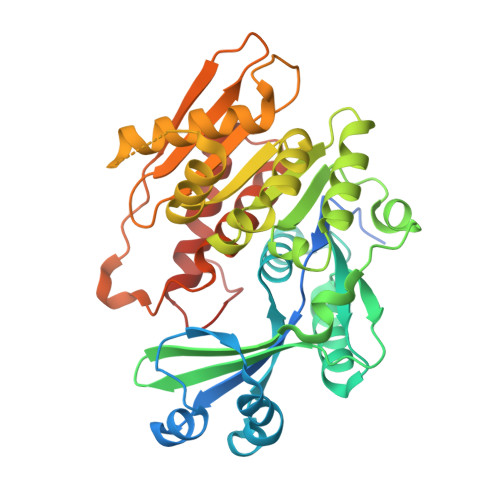Structure of Toxoplasma gondii adenosine kinase in complex with an ATP analog at 1.1 angstroms resolution.
Zhang, Y., El Kouni, M.H., Ealick, S.E.(2006) Acta Crystallogr D Biol Crystallogr 62: 140-145
- PubMed: 16421444
- DOI: https://doi.org/10.1107/S090744490503430X
- Primary Citation of Related Structures:
2ABS - PubMed Abstract:
The obligate intracellular parasite Toxoplasma gondii is incapable of synthesizing purine nucleotides de novo and relies completely on purines salvaged from the host cells. Adenosine is the preferred precursor and is phosphorylated by adenosine kinase (AK), the most active enzyme in adenosine metabolism in T. gondii. AK thus represents a potential chemotherapeutic target for the treatment of T. gondii infections. The previously solved structures of unliganded AK and AK in complex with adenosine (or 7-iodotubercidin) and an ATP analog revealed a novel catalytic mechanism. A domain closure triggered by a GG switch upon adenosine binding sequesters the adenosine and gamma-phosphate of ATP from the solvent. The formation of the anion hole induced by the ATP binding completes the structural requirements for catalysis. In the current study, the structure of a binary complex of AK and the non-hydrolysable ATP analog AMP-PCP was determined to 1.1 angstroms resolution. The overall structure is similar to the apoenzyme, with an open conformation. AMP-PCP is bound in two relaxed conformations and without anchoring by Arg136. The induced anion hole is the same as that in the ternary complex AK-adenosine-AMP-PCP. This structure provides direct evidence that ATP binding at millimolar concentrations does not require adenosine binding as a prerequisite.
Organizational Affiliation:
Department of Molecular Biology and Genetics, Cornell University, Ithaca, NY 14853, USA.

















